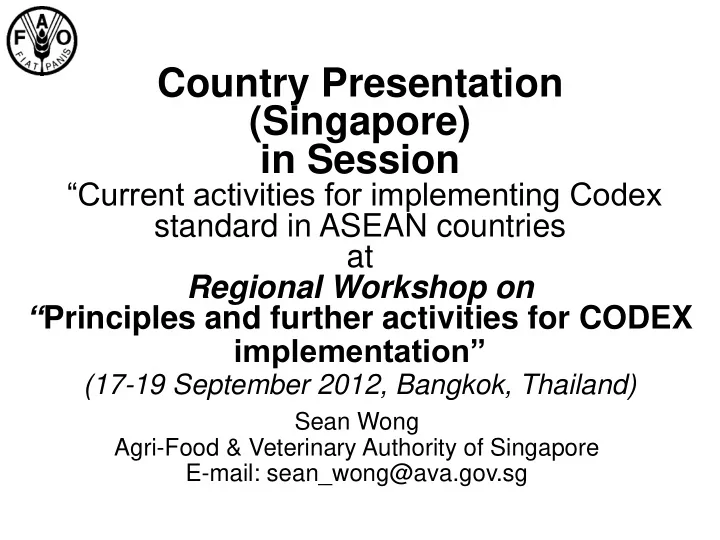

Country Presentation (Singapore) in Session “Current activities for implementing Codex standard in ASEAN countries at Regional Workshop on “ Principles and further activities for CODEX implementation” (17-19 September 2012, Bangkok, Thailand) Sean Wong Agri-Food & Veterinary Authority of Singapore E-mail: sean_wong@ava.gov.sg
Agri-Food & Veterinary Authority (AVA) • Food safety authority in Singapore – Ensures a resilient supply of safe food – From source up to just before retail (The National Environment Agency, working with AVA, oversees food hygiene and safety at retail)
AVA’s Organisation Structure AVA Regulatory Programmes & Operations Group [Headed by Director-General] • Regulatory Administration Department (Accreditation, Risk Assessment and Standards) • Quarantine & Inspection Department (Import Control and Quarantine) • Food Establishment Regulation Department (Control of Domestic Food Establishments) • Agri Establishment Regulation Department (Control of Domestic Farms and animal premises) • Laboratory Department (Diagnostics - animal/plant diseases and pest; food safety) Corporate & Technology Group • Planning & Organisational Excellence Department • Technology & Industry Development Department • Food Supply Resilience Department • Corporate Resource Management Department • Communication & Corporate Relations Department
Structure of National Food Control Systems: Integrated Food Safety System Accreditation / Audit Import control & checks Inspection, sampling, testing
Structure of National Food Control Systems: Import checks Food Safety - A Shared Responsibility Industries Consumers Food safety public education
Level of Codex Implementation: Codex standard and relevant text eg. code of practice, guidelines, specifications: • Adoption as national standards after appropriate risk assessment in local context • Operation and administrative guidelines eg. food hygiene, import and export control systems
Process of Standard Setting Activities Singapore’s food standard setting process Feedback from food industry (eg. Manufacturers, importers or other government or Internal periodic reviews of the Food Regulations agencies) Internal review using references such as related Codex standards, and compare with legislation in major developed countries such as Australia, Canada, the EU, New Zealand, Japan, and the USA. Risk assessment using local food consumption data (as appropriate) Circulation of initial proposal for public consultation and WTO notification Finalising proposals taking into consideration comments received Gazettal of Amendments to Singapore Food Regulations and implementation of standards
System for Data Collection And Analysis • Data collection - obtained from international sources (early warning and horizon scanning) and national sources (institutions, departments and agencies such as Ministry of Health and National Environment Agency): • Import/export data • Food safety surveillance and laboratory data • Food consumption data • Reports • Data analysis • Data analysed against international standards (if available) and assessed in Singapore context. • Involved working groups with members of different disciplines
Prioritized Needs of Capacity Building for Effective Implementation of Codex Standards • Identifying potential food safety hazards: food industry trends (e.g. novel and innovative food products), antimicrobial resistance in foodborne pathogens and use of nanotechnology in foods • Efficient collection of data for assessment and effective use of assessment tools • Continual building of expertise in risk assessment for food, including those for food ingredients and food contact material • Risk-benefit assessment for chemical/microbiological contaminants and nutrients • Effective development and deployment of risk management measures, e.g. in food supply chain management • Effective risk communication including that for food and nutrition labelling and health claims • Continual enhancement of laboratory capabilities, e.g. testing for alpha-emitting and beta-emitting radionuclides in food
Recommend
More recommend